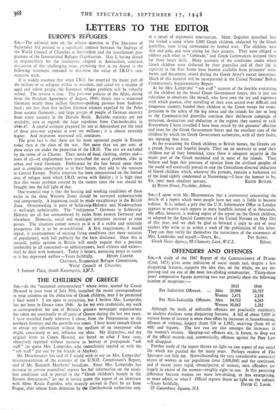OFFENDERS AND OFFENCES
SIR,—A study of the 1947 Report of the Commissioners of Prisons (Cmd. 7475) gives some indication of social trends and, despite a few disquieting features, supports the idea that, on the whole, we are im- proving and are one of the most law-abiding communities. Thirty-three years' comparative figures (covering two war periods) show the following number of receptions:—
1913 1946 For Indictable Offences. ... Men 20,998 20,537 Women 2,871 2,138 For Non-Indictable Offences. Men 84,512 4265 Women 30,862 , 1,282 Although the totals of indictable offences are practically stationary, an analysis discloses some disquieting features. A fall of about 5,000 in various forms of larceny is more than offset by increases in housebreaking, offences of violence, forgery (from 528 to 1,392), receiving (from 60 to 468) and bigamy. The last two are also amongst the increases in the women's returns. Sleeping-out offences are, in future, to drop out of the official records and, automatically, offences against the Poor Law will disappear.
Further study of the report throws no light on one aspect of our social life which has puzzled me for many years. Perhaps readers of The Spectator can help me. Notwithstanding the very considerable numerical excess of women in our population (over 2,000,000) and the continued, and of recent years rapid, emancipation of women, men offenders are largely in excess of the women—roughly eight to one. Is this persisting difference because women are more law-abiding, or less enterprising, or more adroit, or what ? Official reports throw no light on the subject.


































 Previous page
Previous page